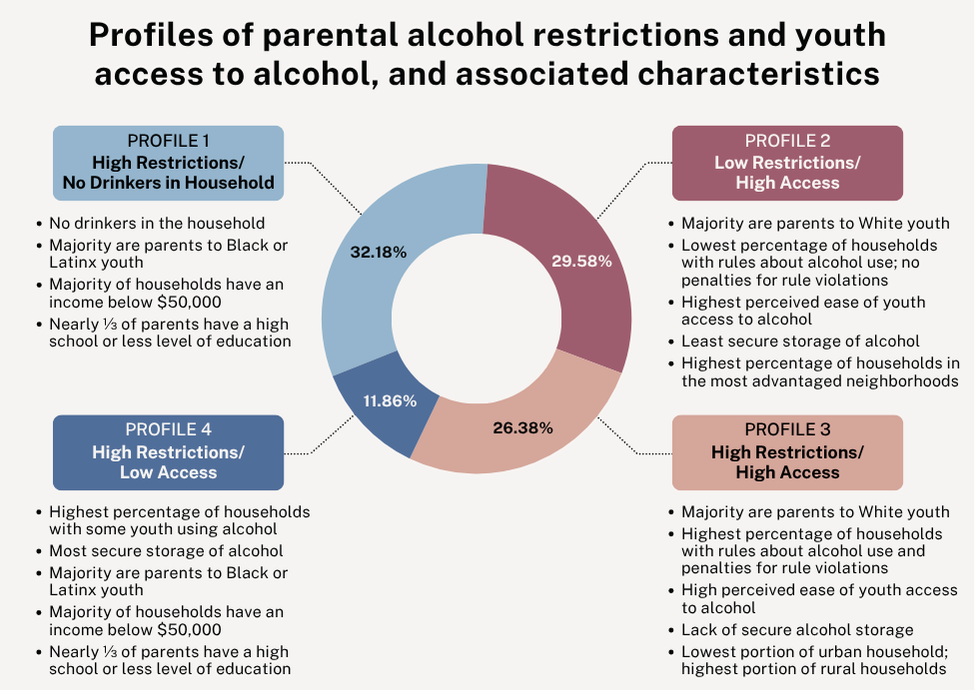The DRAM, Vol. 21(8) – Parental alcohol restrictions and youth alcohol access: Variations by sociodemographic and neighborhood factors
Parents can take proactive steps to prevent their children from drinking underage, such as setting household rules around alcohol use and limiting access to alcohol at home. These decisions may be shaped by how easy parents believe it is for their child to access alcohol—both inside and outside the home. This week, The DRAM reviews a study by Carolyn E. Sartor and colleagues that identified distinct profiles of parental alcohol restrictions and perceived youth access to alcohol, and the sociodemographic and neighborhood characteristics associated with each profile.
What were the research questions?
How do parental alcohol-related rules, household alcohol use and storage, and perceptions of youth access to alcohol group into distinct profiles? How do these profiles differ by sociodemographic and neighborhood factors?
What did the researchers do?
The researchers analyzed data from the ABCD Study—a longitudinal study of adolescent health and development. The sample included 9,586 parents (i.e., primary caregivers) of preadolescents (mean age of 12 years). Parents reported sociodemographic factors, including race/ethnicity (White, Black, Latinx) and income. The researchers geocoded participant data to determine residential setting (e.g., urban, rural) and level of neighborhood (dis)advantage. Participants answered questions about household rules around their child’s drinking and penalties for rule violations (i.e., alcohol restrictions), as well as household alcohol use and storage. They were also asked to rate how easily they believed their child could access alcohol. The researchers conducted a latent profile analysis to identify distinct profiles of parental alcohol restrictions and perceived youth access to alcohol, and distinctions across these subgroups by sociodemographic and neighborhood factors.
What did they find?
The researchers identified four distinct profiles: (1) high alcohol restrictions and no drinkers in the household, (2) low restrictions and high perceived youth access to alcohol, (3) high restrictions and high access to alcohol, and (4) high restrictions and low access to alcohol. While each group had distinct characteristics (see Figure), there were some similarities. The high restrictions/no drinkers in household and high restrictions/low access groups were similar to each other, with more parents to Black and Latinx youth, lower household income, and lower levels of parental education, compared to the other two groups. The low restrictions/high access and high restrictions/high access groups were mostly composed of parents to White youth living in more advantaged neighborhoods.

Figure. Four distinct profiles of parental alcohol restrictions and youth access to alcohol, and their associated sociodemographic and neighborhood characteristics. Each percentage represents the share of the total sample (n = 9,586) assigned to that profile. Click image to enlarge.
Why do these findings matter?
These findings suggest there is nuance to alcohol-specific parenting beyond simply restrictive or permissive. This study identified four parenting profiles that can be distinguished by the level of household alcohol restrictions in combination with perceived youth access to alcohol, which differed by sociodemographic and neighborhood factors. Parent-level alcohol prevention efforts should be tailored for each group. For example, parents of White youth living in more advantaged neighborhoods may benefit from education about secure alcohol storage in the household. Future qualitative studies are needed to help us understand why parents do and don’t set alcohol restrictions, and how this is shaped by perceptions of alcohol access.
Every study has limitations. What are the limitations of this study?
The generalizability of these findings is limited to preadolescents, as parental alcohol restrictions and perceptions of youth alcohol access are likely to change as children age. Parents who reported that no household members drank alcohol were not asked about alcohol storage—based on the assumption that such households do not serve alcohol to non-household members, which may not always be accurate.
For more information:
Parents can find guidance on talking to their children about alcohol from the National Institute on Alcohol Abuse and Alcoholism. They also provide tips and resources for people looking to change their relationship with alcohol. For additional drinking self-help tools, please visit our Addiction Resources page.
— Kira Landauer, MPH
Want CE credit for reading BASIS articles? Click here to visit our Courses Website and access our free online courses.